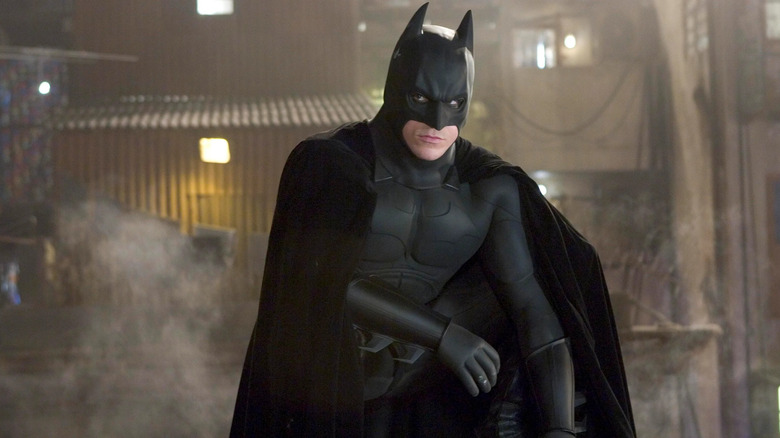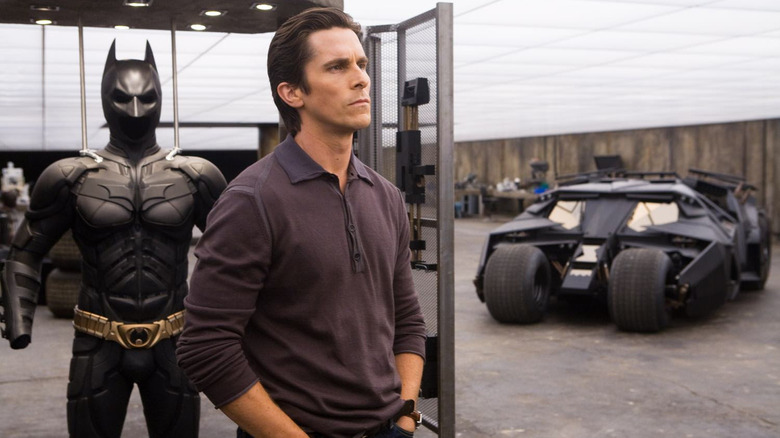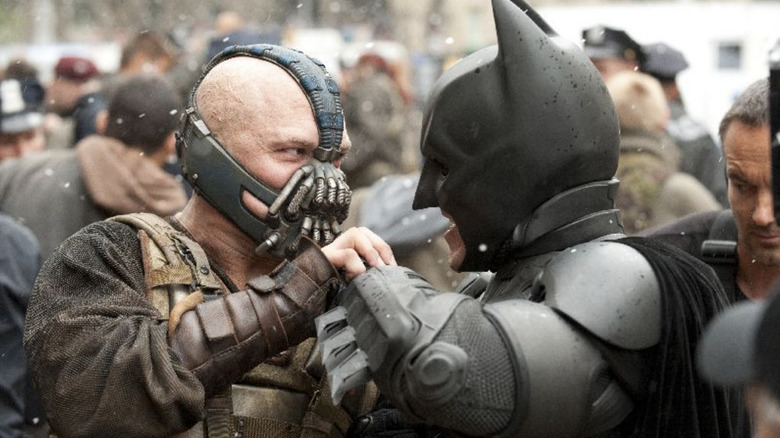Bringing Realism To Batman Begins Gave Christopher Nolan's Trilogy Its Arc
When Tim Burton made his superhero noir "Batman" in 1989, his aesthetic choices were based on a very specific ethos. Because Batman was such an outlandish character (what with the bat costume and all) he wouldn't fit logically into the real world. Burton could either alter Batman in ways that he looked more realistic — anathema at the time — or he could alter the world so that it fits comfortably around a costumed vigilante. Burton took the latter approach, turning Gotham City into an expressionist landscape of colorful criminals and scary, near-supernatural shadows. The idea of shaping the world to fit Batman was an artistic approach that followed the character all the way through the mid-2000s.
When Christopher Nolan made "Batman Begins" in 2005, he took the opposite approach. Yes, Batman was still to be a caped vigilante in a silly-looking bat helmet, but Nolan constructed an elaborate sequence of events that logically explained every last aspect of Batman's existence. What, he asked, would have to happen in the real world to actually create a real Batman? Yes, "Batman Begins" was still a superhero fantasy film, but it was seen as more realistic than anything that had come before. Nolan's approach was so well-received by audiences, that the "realistic origin story" became a massive subgenre unto itself.
In a 2015 interview with Forbes, Nolan laid out his "logical" approach to Batman, explaining that he and his co-screenwriter, David S. Goyer, deliberately selected a "realistic" approach to the superhero. Eventually, this approach came to inform the stories of Nolan's two sequels from 2008 and in 2012. Not only did he "logic out" how a Batman would come into being, but also that he had a specific goal in mind ... and that it could be achieved.
Batman began, and Batman ended.
A realistic version of the story
Nolan explained that before thinking out the physical fineries of Batman — his cape, his helmet, etc. — he and Goyer tried to figure out the philosophy of Batman. What kind of things would a human being have to believe in and accept if they were to find logic in dressing up like a bat and punching criminals? Nolan said:
"I think the idea that Bruce Wayne perceived of Batman as a symbol that could rally the good people of Gotham was something that very much came to David Goyer and myself as we explored the logic behind his actions. We were setting out to try and tell a more realistic version of the story, and of the origin story, than had been done. The origin story had never been addressed in films."
In previous iterations, viewers were simply asked to accept the fantasy of Batman, understanding that superheroes are merely logical in their own world. Indeed, much of the appeal of superheroes is their place in a clear, easy-to-understand world of moral absolutes. That is: good guys are good, and bad guys are bad. If there are evil cartoon villains, then it stands to reason that there are righteous cartoon heroes. This was a facet of comics that Burton got right, a facet Nolan admires. But, he said, he wanted more:
"What Tim Burton had done very brilliantly with his very Gothic, very idiosyncratic version of Batman, didn't necessarily address the idea of a more real world and coming up with more real-world explanations for what Batman is."
Certainly, in Burton's film, Batman's only explanation for his behavior is "This is just something I have to do." The "why" is not answered.
Batman ends
In "The Dark Knight Rises" — for my money one of the best of all Batman movies — some fundamental questions are addressed regarding Batman's existence. Foremost, the film points out that Bruce Wayne is a billionaire, and that if improving Gotham's quality of life was his goal, then perhaps being a Batman wasn't the best use of his money. "Rises" also posits a Gotham City that actually can be improved, at least to the point when it may no longer need a Batman. Additionally, how long did Bruce intend to keep playing dress-up? In live-action, Batman is noticeably mortal, and retiring should be an option for him.
Nolan acknowledged that Batman was more of a symbol and that Bruce Wayne had goals beyond using Batman violence as his therapy. Nolan said:
"As we started analyzing that and really thinking about the logic of it, and what that would be in the real world, we came to the realization that for us, for our interpretation of Bruce Wayne and Batman in the real world, it should be a symbol. It should be something he sees as a catalyst for change."
Once that catalyst had been presented, Nolan found that Batman's mission was not unending. As such, "The Dark Knight Rises" presented comic book fans with the rarest of story elements: an actual ending. He said:
"[W]e always presented it, and were consistent with it in the three films of mine, as a finite mission in his mind. Which I know is a controversial aspect of the character, but it made the most sense to us to say he sees it as a lever for improving things in Gotham, for getting the good to take back their city from evil, and that at a point that mission will be finished."


